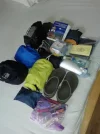marclynnette
New Member
- Time of past OR future Camino
- May (2013)
Hola!
Leaving in FOUR WEEKS TODAY. Got all our supplies ready to go. Shoes getting broken in. My only problem is how to properly pack our bags. I read some helpful links, but it just doesn't seem right. What suggestions do you have for packing your bag correctly? Where should it hurt (if anywhere) at first? What tips and tricks do you have?
Here's what will be in the bag daily (briefly):
- sleeping bag
- jacket
- t-shirt
- turtle neck under armor
- 3L water pouch (should I fill it all the way?)
- 1 underwear/2 socks (put in zip lock bag)
- all my bathroom/med care stuff in a zip lock bag)
- pillow liner
- sleeping clothes (tshirt/shorts)
- sandals
- poncho
- bag cover
- sunscreen
- guide book
Looking forward to learning!
Leaving in FOUR WEEKS TODAY. Got all our supplies ready to go. Shoes getting broken in. My only problem is how to properly pack our bags. I read some helpful links, but it just doesn't seem right. What suggestions do you have for packing your bag correctly? Where should it hurt (if anywhere) at first? What tips and tricks do you have?
Here's what will be in the bag daily (briefly):
- sleeping bag
- jacket
- t-shirt
- turtle neck under armor
- 3L water pouch (should I fill it all the way?)
- 1 underwear/2 socks (put in zip lock bag)
- all my bathroom/med care stuff in a zip lock bag)
- pillow liner
- sleeping clothes (tshirt/shorts)
- sandals
- poncho
- bag cover
- sunscreen
- guide book
Looking forward to learning!



















